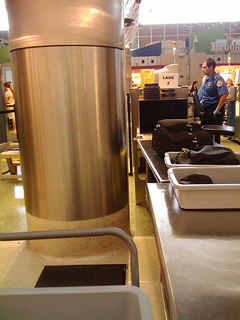Must it be so miserable? Cheap fares and favorable weather may be outside the reach of good design, but surely some aspects of the flying experience could benefit from a little UX love. We asked a few of our experts how to make trips to the friendly skies more user-friendly.
What are airports doing, and what can they do, to become nicer places to spend time?
Andy Polaine: We talk a lot in service design about the transitions between touchpoints being as important as the touchpoints themselves, if not more so. The reason why we have so many bad experiences—even with services whose individual parts seem well-designed (think of even good airline websites and check-ins)—is that the parts in between are not designed at all. Those dead spots don’t have to be filled with entertainment and lots of noise, but they could be way better than standing in a long queue in very dreary surroundings.
One example of this is the security area in Göteborg Landvetter Airport in Sweden, which is decorated like a nice hotel foyer, as you can see in this photo I took. (I rushed the photo because I’ve gotten so used to the idea that I might get arrested for taking out a camera in security, although probably no one would have minded.
It still has X-ray machines and scanners, but they’re clad in white instead of jailhouse grey; it’s actually a pleasant environment to wait in and doesn’t make you feel like a criminal. I think a lot more could be done to encourage that third space downtime rather than trying to use it to force more stuff onto us.
Mike Fisher: To Andy’s point, one of the recommendations I made to [an airline I consulted for] a while back had to do with making their gates more pleasant and traveler-friendly. Fortunately for all of us, in the last few years some airlines have begun to look at their gates as part of the overall experience—in some cases offering simple conveniences like power plugs—though I think overall they could go further.
Some airports (Portland’s comes to mind) have done a good job of improving the experience of their public spaces and making them more relaxing and traveler friendly. Minneapolis’s Humphrey terminal has several areas set aside with restaurant booth-style seating areas and power. And at each of the terminal elevators they’ve thoughtfully placed pencils and notepaper for travelers to write down the location of their car.
Sadly, I have yet to come across a good TSA experience; they seem to be varying shades of awful. Even if we assume that body scanning is necessary (I certainly don’t think so, but that’s a different conversation), there’s plenty of room for improvement in terms of logistics and basic service design. For example, at the U.S. airports I’ve seen there appears to be no system in place to quickly respond to increased passenger flow by bringing more agents online to check boarding passes. I suspect they have some system for this, but if they do, it’s not adequate. Instructions could be better, too. I’ve watched a lot of novice travelers get caught up in various shoe/belt/laptop/toothpaste conundrums because the rules are explained inconsistently or not at all.
Indi Young: The airline I consulted for seemed to think that the “club” lounges were what they should concentrate on. We heard quite a bit from passengers about both gate and lounge experiences. There was a lot of frustration expressed by people hoping to use the lounge but being refused entry. (The airline has very complicated policies regarding when passengers can use the lounges.) But the airline was putting effort into its lounges and its check-in process, not the gate experience.
I think they ignored our findings because they’re not used to investing in something that doesn’t directly return a profit. Investing in improving the “dead spots,” as Andy put it, would result in more passengers choosing that airline, but that isn’t a directly connected profit. At least that is what I think their reasoning is; I was blocked from speaking with the decision makers. (I’m still trying.)
Oddly, the airline was also interested in creating a vacation-choosing service. None of the 100 people we listened to needed help figuring out where to go on vacation, but I think our findings fell on deaf ears. Someone higher up was excited about lounges and vacation-choosing services, and so that’s what was happening.
Meanwhile, as a contrast to Andy’s photo of Göteborg Landvetter Airport, here’s one I snapped (surreptitiously, for the same reasons) of an obstacle passengers have to navigate to get through security in San Antonio International Airport.
A lot of people may not realize that airports’ customers are, in fact, airlines, not passengers. How does this impact airports’ attitudes toward the people who flow through their space?
Indi Young: In my year-plus with [a major airline], I found out they have an “attitude” about the airports. Airports aren’t owned by them, and any physical upgrades, especially infrastructure upgrades, are done by the airport itself. It’s kind of like leasing office space. You do your own decor, but most of the stuff is already in place. (Seats, doors, windows, carpet, outlets, etc.) You could negotiate for some upgrades, but somehow the attitude is to not prod that sleeping dog.
Andy Polaine: Yes, this will be news to a passenger who has spent anything between a few hundred to a few thousand dollars on tickets, only to be treated like a criminal at best and mindless shopping robot at worst. It is an example of a broken, reverse, or negative service ecosystem from the customer perspective.
It is an example of a broken, reverse, or negative service ecosystem from the customer perspective
It’s also a great/bad example of how the cracks between the different service providers aggregate to form an experience crevasse. Each provider or department believes it’s someone else’s job to deal with experience X (the “attitude” Indi mentioned). I’m sure, if it was about branding, the airlines would put pressure on the airport to change the decor. When it is about passenger experience, they don’t have to bother because they’ve already got your money. That’s what happens when a service is sold with a product mentality—it’s not about an ongoing relationship, but selling someone a ticket and getting out of the relationship as quickly as possible with the minimum amount of commitment.
Why is there such a difference between countries in the quality of air travel?
Andy Polaine: There are some real differences that are, in my experience, usually cultural clichés but relatively true. I recently experienced the difference between Germany’s Lufthansa and Singapore Airlines on my way to and from Australia. Same planes; very different cultures of service and ambience. Singapore was very much about warm service; Lufthansa was efficient and not unfriendly, but a little bit withheld. These are small generalizations, and I’ve experienced the opposite on both airlines, but this was my overall experience.
There are also cultural norms in the sense of what passengers have been educated to put up with. I see Americans taking their shoes off for the X-ray machines as a matter of course, even though they’re not required to. They’ve just clearly gotten used to having to go through such a rigamarole with TSA.
Mike Fisher: I traveled to Tel Aviv on El Al a couple of years ago and found both the in-flight and in-airport experiences fascinating. El Al not only served reasonable food (at least by American standards), they left plenty of snacks in the galley area and encouraged passengers to “graze” while stretching their legs during the long flight. I think on a U.S. flight you’d be either admonished or tackled for taking food from the galley without explicit permission.
At Ben Gurion Airport in Tel Aviv, the security agents couldn’t care less if you have a bottle of water or a tube of toothpaste with you (in fact they laughed when I asked if I should throw it away). Instead they watch expressions, body language, and other factors that can reveal a potential troublemaker. They achieve a very high level of security with a relatively small staff, and without wasting resources the way TSA seems to. Baggage gets scanned by machine but people receive individual scrutiny. It’s a smart system and in my view far less invasive than what we’ve become used to with the TSA.
Indi Young: In the U.S. sometimes the flight attendants are not completely on board with the airline, if you will allow me that euphemism. Flight attendants often belong to a separate organization that frequently fights with management. I’m not sure about gate and counter personnel, but in all cases, it’s these employees who interface with passengers the most. Again, attitude plays a big role, whether positive or negative. The passengers I listened to didn’t tell stories about differences in countries (except Amsterdam’s airport, which apparently draws everybody’s ire). They did tell stories about individual personnel members who treated them with great suspicion—assuming that this passenger was thinking the worst or being greedy, and letting that assumption influence their treatment of this passenger.
In our research, we were unable to get the higher-ups interested in a study involving gate personnel or flight attendants. The one flight attendant that I got to listen to at length is a purser on international flights—she’s in charge of all the personnel on the plane, except the captain and others on the flight deck. She even complained about the attitude the flight attendants had: “I’d rather be serving the masses than catering to the asses.” Or vice versa. She implied that flight attendants (clearly not all of them) either prefer to work in Economy and deal with passengers’ uppity demands with a level hand, or to serve in Business or First Class, where the demands are at least valid, because passengers have paid more, but they tend to treat flight attendants like servants. You can begin to see where flight attendants, and gate personnel, come from; they don’t like being treated like servants. They don’t like being asked for extra services that aren’t a part of their normal work process. They try to limit their interaction with passengers and treat everyone with their own rote style of interaction. One flight attendant told me, “I’m only here for safety.” Of course, this is not true of everyone. I wish I’d been able to hear from the gate personnel and flight attendants. But to answer the question, the differences in treatment come more from the attitude of the personnel, based on their work conditions and how they personally handle dealing with hundreds of passengers a day. Many airlines don’t seem to have any strategy around this. Some do.
Like what these experts had to say? You can bring their brains to you. Mike Fisher, Andy Polaine, and Indi Young are available for consulting and training through Rosenfeld Media. Image of airport courtesy Shutterstock.












